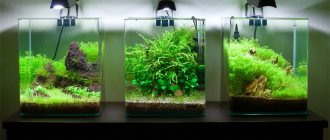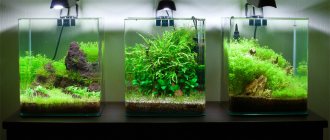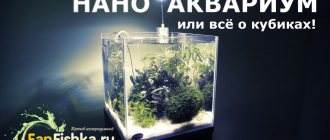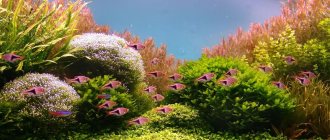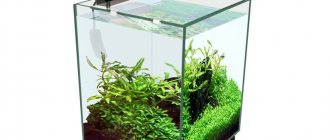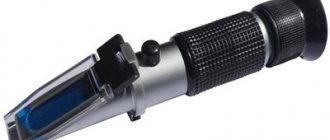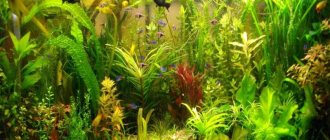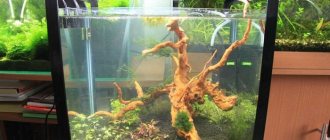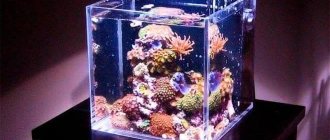Description
Difficulties in keeping are associated with the inability to maintain stable biological balance. Balance involves establishing the nitrogen cycle.
- Fish produce nitrogenous compounds and carbon dioxide (CO2), which are converted by aquarium microorganisms into dangerous ammonia (NH3).
- With the help of nitrite bacteria, ammonia is oxidized to nitrites (a salt with the base NO2). Ammonia and nitrites are absorbed by algae. Rapid growth of algae indicates an increase in the concentration of unacceptable compounds.
- Nitrate bacteria convert nitrites to nitrates (salts with the base NO3). Plants feed on nitrates and CO2, saturating the environment with oxygen.
The more plants there are in a nano aquarium, the less likely nitrate poisoning of fish is. Balance is easier to establish.
Stores sell ready-made kits of nano aquariums with a set of equipment. Available in different shapes and sizes. Made to order. Craftsmen make nano aquariums with their own hands for a specific installation.
Fauna should not be placed in aquariums up to 5 liters. They make decorative herbalists.
Choosing an aquarium
To retain water, silicate or organic glass is used. Products made of silicate glass are fragile and are susceptible to impacts. Do not get scratched during mechanical cleaning of algae.
Plexiglass or plexiglass (polymethyl methacrylate, PMMA) is called "glass" only because of its transparency. In fact, it is a synthesized polymer, plastic.
- Resistant to impacts.
- Takes the desired shape when exposed to temperature.
- Products made from PMMA are lighter than glass.
- Available for machining.
- Transmits 73% UV light.
- Thermal insulator.
Flaws:
- scratches easily;
- rendered unusable by solvents (acetone, alcohols).
Plexiglas is used to make aquariums of complex shapes. Or if there is a risk of impacts (children's, kitchen) and safety is required. Nano aquariums of 10 liters are often made monolithic (seamless).
The shape of the aquarium determines the location and internal design.
- A traditional can has an aspect ratio (WxHxD) of 2 x 1 x 1. A cube has equal sides. These forms facilitate maintenance and are optimal for ventilation. The screen has a shallow depth: (WxHxD) 2 x 1 x 0.5. It looks interesting, but the bottom area is not enough for plants, and the surface is not enough for air supply. The “trough” shape ((WxHxD) 2 x 0.5 x 1, 2 x 1 x 2) is rarely used for nano aquariums.
- The corner one will save space and provide the maximum size of the viewing glass. Sharp corners will make cleaning difficult. Convenient to install on your desktop.
- Wall-hung with a vertical or inclined front wall is rarely used in nano aquariums. Maintenance is difficult due to the height of the location.
- A cylindrical aquarium is suitable for a central location. Distorts dimensions. For viewing and maintenance, the hexagonal one is more convenient. Disadvantage: It is impossible to create a backdrop or background.
- Spherical (round) - a mockery of the owner, the fish and common sense. To plant plants you will need a quarter of the height of the vessel. Equipment placement is a problem. Contaminants settle both on the bottom and on the walls. Cleaning the glass is difficult. Water is not saturated with oxygen. Proportions are distorted. The “designers” put large goldfish there. It is painful to watch the inhabitants suffocate. In Italy they decided to ban it.
The option of a standard quadrangular aquarium seems rational. Convenient for equipment placement and maintenance. A 40 liter vessel has linear dimensions of up to 40 cm, the edge of a 30 liter cube is 31 cm, it will not take up much space. A special cabinet is usually not required.
What kind of fish are suitable?
Fish accustomed to fast currents are not suitable for a nano aquarium: the linear dimensions of the vessel are required from 10 times the length of the inhabitant. Active large specimens and medium-sized gregarious specimens are not suitable. The preferred hiding places are not suitable for decorative purposes.
Cockerels
The term “nano fish” does not mean nano size. Decorative qualities and a tendency to have their own limited space (territoriality) are important.
The Siamese cockerel has a bright exterior and does not need company. Body length is up to 7.5 cm. Lives well in a five-liter aquarium. Double-breathing, does not depend on aeration. Recognizes owners and is inclined to communicate.
Disadvantage: in a nano aquarium it only gets along with the female.
Neons
An example of schooling fish for a nano aquarium is neons. For a flock of 6 individuals, ten liters is enough. They grow up to 3.5 cm in length. They need aeration, but do not like intense currents.
Gourami
Trichopsis (dwarf gourami) will entertain owners with its ability to make audible sounds. 3–3.5 cm in length. Lungbreathing, lives at room temperature. Does not require aeration or heating. 10 liters is enough for a couple of fish.
Guppy
Beautiful fish for a nano aquarium. For a couple (male and female) 5 liters is enough. Males - 3–4 cm, females - up to 6 cm. Unpretentious, live at room temperature. Aeration is desirable. Viviparous, after 3-4 months aquarists are faced with the problem of overpopulation due to reproduction. In containers of 30 liters or more they get along with all peaceful species.
Epiplatis torch
This exotic fish, native to Central Africa, will surely decorate any small aquarium. It is also called the clown pike because of its very bright multi-colored color and some external resemblance to an ordinary pike.
True, the size of this African is much smaller - no more than 3.5–4 cm. And the females are even smaller.
Epiplatis cannot be confused with any other fish thanks to its tail. Large, bright red with blue stripes, it really does resemble a torch.
The clown pike is peaceful and calm. However, it is capable of jumping out of the water, so the aquarium must be kept closed at all times.
It loves soft water with a temperature of 23–26 degrees above zero and a neutral pH.
The fish picks up food only from the water surface, so food (brine shrimp, cyclops, daphnia, dry proprietary mixtures) should be given in small portions.
Animals
Together with fish or separately they contain crustaceans (crayfish, shrimp) and snails. Crayfish in a nano aquarium are rare, since they are poorly compatible with shrimp and fish, and the capacity is insufficient. Shrimp and fish do not quarrel, but they are afraid of predators.
Shrimps
Shrimp serve as an indicator of water quality. If they stop moving, hide, or try to leave the aquarium, expect trouble.
They perform a sanitary function by eating up leftover food. They eat algae that is harmful to plants. But if there is an excess of nitrites, they will not get rid of the invasion.
The cherry tree (up to 3 cm) is widespread and reproduces in nano format. Amano shrimp (up to 6 cm) do not reproduce, but are effective against algae. Cherry shrimp requires 1 liter of water, Amano requires 5 liters.
Elassoma evergladei
This fish is one of the lesser known nano fish in the aquarium hobby. These fish love heavily planted aquariums with slow water movement. Males exhibit much of the behavior of cichlids during spawning. They spend their time dancing around the female and will fiercely defend the eggs. Elassoma Everglades are somewhat difficult to keep, as they mainly love live and frozen food.
Maximum size: 2.5 cm. Minimum aquarium size: 5 liters
Plants
Plants for a nano aquarium are selected based on the linear dimensions of the jar. Preference is usually given to dwarf species, plants floating in the water column, ground cover and mosses. Surface views obscure the scenery.
Anubias barteri var. Nana (Anubias barteri var. Nana) grows up to 15 cm. Unpretentious, resistant to low light. Slowly growing.
Australian bacopa (Bacopa australis) grows up to 30 cm in its intact form. It grows quickly and requires light. When it grows in the area, weed it. It tolerates haircuts painlessly and is used for aquascaping.
Java moss (Vesicularia dubayana) is used to “green” rocks and driftwood. It has no roots, but when fixed to the surface it clings securely. Unattached, it lives in the water column. Grows quickly, does not like excessively bright light. Actively participates in nitrogen turnover; nitrite and nitrate bacteria multiply in thickets.
Take a look at this post on Instagram
Additions, expansions Konstantin A. (@avakote) 8 Sich 2021 r. about 9:35 PST
Cladophora (green balls) are not recommended: they love cold water and become infected with algae. They need constant washing, otherwise they look sloppy.
Certain plant species require carbon dioxide (CO2) ventilation. Stimulates photosynthesis and plant growth. Increases the oxygen content in water.
CO2 blowing is only relevant for plants. It has no effect on living organisms.
Nano aquarium design “Green Island”
Nano aquarium design
Light, airy composition, but requiring skills in growing plants. The essence comes down to creating a hummock - take a stone onto which the appropriate plants and mosses are glued . In this case Bucephalandra , a few dwarf Anubias , taller plants in the background - Hygrophila pinnatifida , Staurogyne bihar. And on the sides there is an aquarium star - Pogostemon helfera .
We'll talk about plants below. Here we note that in planted aquarium cubes, in fact, as in other herbalists, you need to maintain a balance: lighting + CO2 + fertilizers and water parameters .
The advantage of nano-aquariums is that you can easily install above them any and, most importantly, inexpensive lighting necessary for the plants you have chosen: be it construction spotlights, Chinese Chihiros or any other branded light.
Our recommendation on this issue is simple. Street spotlights = 500 rub. Good spectral nano-lamps = 1500-2000r. The choice is yours. As part of the fact that in this article we review Gloxi complets. Here's a video of their lights.
Two warrants: The first is an 18W GLOXY Q2 LED PLANT lamp with lenses, which adds power. It is well presented in the video clip above. Most plants can be grown under it. The second option is the Gloxy Optic LED Professional lamp. This is a standard lamp that comes with the kit if you buy a can. But it is also sold separately.
The disadvantage of the cubes, in our opinion, is their small height - you need to think carefully about mixing CO2 - you need a good diffuser sprayer that produces fine bubbles, you need to think about the flow of water - make sure that the CO2 bubbles linger in the water as long as possible. But again, this is all a matter of technique and experience. Not everything is so difficult if you read FanFish and learn from Nature =)
Equipment
- In conditions of limited space in a nano aquarium, an external filter is recommended. Taking into account unstable conditions - with bioprocessing. Productivity – from 8 vessel volumes per hour.
- A heater with a thermostat is necessary for tropical and subtropical fish and plants, shrimp. Preferably submersible, horizontal, bottom. Easy to mask, no need to turn off when changing water or cleaning.
- Control thermometer.
- A compressor with a sprayer for blowing air if there is no aeration in the filter. Productivity - 0.8–1 liter of air per hour per 1 liter of water.
- CO2 purge equipment (if required).
- Cover for an aquarium.
- Control tests: pH, kH, dH, NH3/NH4+, NO2, NO
- Siphon for removing dirt.
- Scraper for cleaning glass. Magnetic is convenient, but looks out of place in a small jar.
- Net. The size of the frame depends on the type of fish chosen.
Microassortment of erythromicron
Perhaps one of the most popular species for miniature aquarium keeping is the rasbora. And in their family we can distinguish a wonderful, beautiful fish called “Microrasbora erythromicron”.
Measuring only about 2.5–3 cm in size, it is ideal for a small tabletop pond. This micro-dispersal, brought to us from Myanmar, was discovered not so long ago, but it has already gained wild popularity precisely due to the ease of keeping it in small volumes of water.
The fish has a nice tiger color: transverse light stripes run through the entire gray-blue body, transparent fins have a reddish tint.
There is nothing particularly complicated in the content of this analysis:
- optimal temperature - from +22 to +28 degrees,
- neutral water hardness,
- its weekly replacement in the amount of 20–25%,
- the presence of filtration and moderate aeration.
There is no need to create a strong current in the “bank”, since erythromicrons love calm water.
For normal maintenance in a small aquarium there must be a zone of vegetation or at least some floating plants.
The fish feeds on zooplankton in natural conditions, but in captivity it is usually fed frozen cyclops, daphnia, and commercial dry food for carp fish.
This microbreed is boring alone, so it is better to have a small flock of 4–5 individuals.
Scenery
Designers believe that there is no place for purchased decorations in a nano aquarium. There is a high probability of introducing toxins with plastic, and a self-made grotto or just a stone surrounded by greenery is original and wins in terms of entertainment.
Driftwood is suitable from the roots of non-resinous trees (except oak). Remove the bark, boil in salted water for 5–8 hours in 3–4 portions, replacing the liquid. Soak in daily replacement water until coloring stops. If it doesn't sink, tie a stone.
Place the background on the back wall. We sell ready-made self-adhesive film or use the original one. Can be painted.
Nano aquarium design “Volcano”
Nano aquarium design
The highlight of the design in the “Ala'Vulcan” style is simplicity! You don't need to be an aquascaper to put together such a textured composition. All you need is a Gloxy Optic Set cube , small gray diabase (“Stones for a bath”, a huge box for 300 rubles, sold in any construction supermarket), an internal aerator and a volcano, other decor that can be found in stores in your city, online stores , on the same Aliexpress, for example, at a glance the car is here .
There is another advantage of designing such a volcanic nano aquarium. As you can see, aeration is very powerful - this will promote good oxidation and removal of nitrogen compounds from the aquarium. If you first place a biosubstrate, for example, lava chips, under the sand, you will get excellent biofiltration and a stable biobalance of the aquarium . That is, in our opinion, it is possible to do without installing any filtration equipment. All that will need to be done as part of caring for such an aquarium is a light siphon of sand and high-quality water changes according to a proven schedule. All!
If you like this kind of aquarium design. If you are a Glofish . You love the coziness that this style of aquarium creates in the evening. Just do it. In such aquariums, in our opinion, the most important thing is “cozy evening light”; you can’t get away with construction spotlights here. Good blue light is needed, preferably UV.
A good option would again be a lamp from the Gloxy Glow light UV Professional series, which is designed specifically for such purposes - obtaining the maximum fluorescence effect for Glofish fish and special decorations. Go on a spree.
Launch - step-by-step instructions
A beginner will understand what a nano aquarium is after the first unsuccessful launch.
- Prepare water that has been standing for 2-3 days or by osmosis. Use air conditioners only if the water parameters do not meet the recommended ones.
- Place the background on the back wall of the aquarium.
- Apply the soil dressing according to the included instructions.
- Place the soil and decorations. At the center of the viewing glass there is a layer of soil - 2 cm, at the rear and sides - 5-6 cm. The slope will facilitate the collection of contaminants.
- Fill the aquarium halfway with water and start planting. Before planting, disinfect the plants by immersing them in a light pink solution of potassium permanganate for a couple of minutes.
- Fill the vessel and place the equipment.
- When the cloudiness of the water passes, but not earlier than after 3 days, carry out tests. If the tests are satisfactory, change 1/3 of the water and introduce the first couple of inhabitants and snails.
- Connect lighting, filtration and aeration.
- After a day or two, start feeding.
- After 4–5 days, if the water has not become cloudy and the inhabitants are fine, launch the next pair.
The launch is considered successful if the water has not deteriorated within a week, the inhabitants have a good appetite, and their behavior is calm. The fact that algae appears is alarming. Remove and replace 1/3 of the water.
Pygmy catfish
The peaceful bottom fish Corydoras Pygmy is one of the smallest catfish, it reaches a length of no more than 2 cm. A characteristic feature is a horizontal thin line running along the silver-gray body.
Content specifics:
- catfish like to hide among vegetation and prefer dim light. To create natural conditions, fallen leaves and driftwood are added to the aquarium, and the bottom is covered with sand;
- Corydoras pygmies are unpretentious in food, they can eat frozen and artificial food;
- catfish behave more confidently when kept in a flock of 6-10 individuals;
- the optimal temperature is 24ºС, the acidity is neutral, but they can easily tolerate slightly alkaline and acidified water.
Proper care
Inspect the aquarium daily. Turbidity in the environment, unusual behavior of the inhabitants, active growth of algae are reasons to conduct tests. Hardness, temperature and acidity are determined by the composition of the inhabitants. Limit concentrations:
- NH3 - 0.01 mg/l;
- NH3/NH4+ (complex) - 0.5 mg/l.
Change 15% of the water twice a week. Large-scale substitutions upset the balance and are carried out out of necessity. Always have a supply of water that has settled for 2-3 days for emergency changes. Check the condition of the filter element weekly.
Feed the fish 1-2 times a day. Live fish food is preferable: it does not clog the aquarium. Uneaten dry or frozen - remove.
Caring for plants involves removing algae. Weed out excess greens.
Reviews
Opinions are opposite. Some aquarists do not have nano aquariums, while others do not have full-size aquariums (there are few of them).
The nano aquarium captivates with its compact housing of dwarf species of fish and plants.
